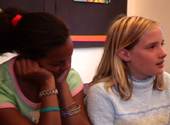Revision |
Mary Hurley was concerned that the way her class was structured in prior years was neither meeting her needs nor the needs of her students. Few were enjoying math or pursuing deeper mathematical questions. Students were also progressing at different rates. She implemented math groups to better negotiate the pacing guide, district benchmark assessments, standards, curriculum, and the priorities she identified as a teacher. Inspired by a team-based middle school mathematics curriculum with which she had previous experience (CPM), she decided to try a more collaborative approach. With 33 students, she felt having them work together might provide support in various ways that she was not able to provide to them individually. Realizing there was nothing explicit in the curriculum or the pacing guide to prevent her from using a more collaborative approach, she restructured her math time to include groups for the students' work in math. |
|
|
Classroom video |
|
Math Groups |
|
|
Math groups consist of four students who are members of the same team for four weeks. All in-class work, with the exception of required assessments, is done in teams. Students have a primary partner in this team but also draw on all members for support. Each student is responsible for making sure all team members have done the work correctly and have an understanding of the math. Assessments can be based on one randomly chosen group member's oral or written response. Each team member receives the assessed student's score, thus ensuring each member is invested in the whole team's understanding.
|
|
|
|
 Negotiating the Fifth Grade Math Curriculum:
Negotiating the Fifth Grade Math Curriculum: 
